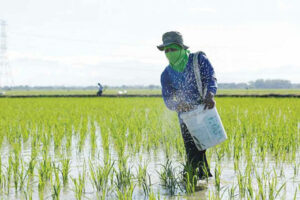THE Department of Agriculture (DA) said it hopes to achieve sufficient scale with biofertilizer by October or November.
“In October-November, the program will start with large-scale promotion of biofertilizer,” Agriculture Undersecretary Leocadio S. Sebastian told a Laging Handa briefing.
Mr. Sebastian said biofertilizer will help the Philippines weather any price volatility in inorganic fertilizer, which commanded P3,000 per bag last year following the Russia-Ukraine war.
According to the Fertilizer and Pesticide Authority, the price of prilled urea and granular urea between May 8 and 12 was P1,970.42 and P1,758.10 per 50-kilogram bag, respectively.
In a memorandum order dated April 27, Mr. Sebastian issued the implementing guidelines for the distribution of biofertilizer. The guidelines seek to achieve savings of P2,000 by replacing at least two bags of inorganic urea (P4,000) with one bag of biofertilizer (P2,000).
The Palace has said that President Ferdinand R. Marcos, Jr., who is also the Secretary of Agriculture, wants to increase the use of biofertilizer to reduce dependence on imports.
Biofertilizer is enriched with microorganisms typically using raw material like crop residue or animal manure.
Mr. Sebastian said that the continued use of “synthetic fertilizer” has resulted in poor soil health and lower rice production and called biofertilizer a means to achieve “balanced fertilization.”
“Synthetic (fertilizer) can only give nitrogen, potassium, and phosphorus… we are not able to apply micronutrients and macronutrients,” he said.
“The quality of soil will eventually improve over time (with biofertilizer). We’re going into a more sustainable, eco-friendly, climate-friendly rice production in the Philippines in that kind of technology,” he added.
Mr. Sebastian said the DA will provide vouchers to farmers next year allowing them to choose their preferred biofertilizer. — Sheldeen Joy Talavera
